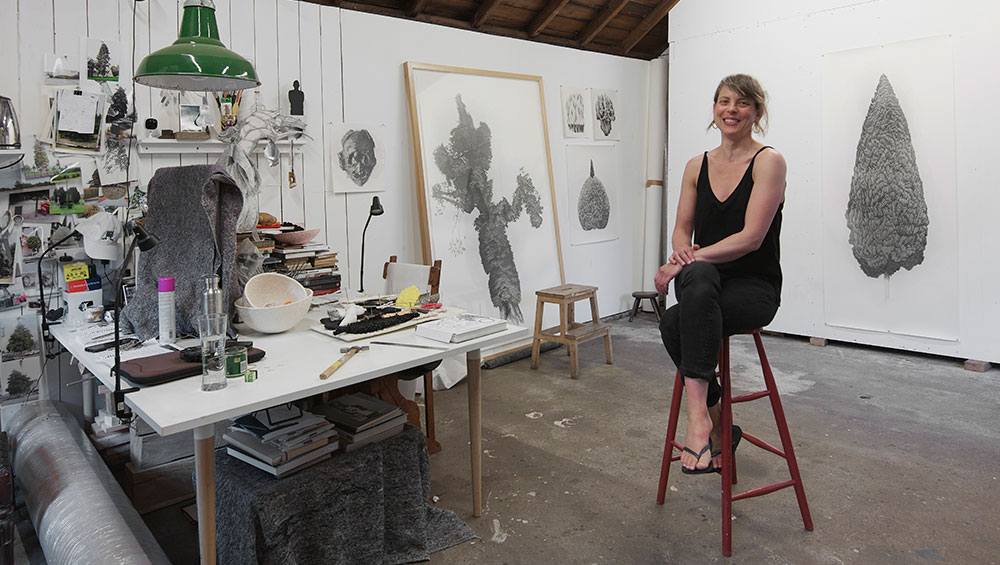
Kate Atkin in her studio.
by DAVID TRIGG
In a converted scout hut tucked away in a bucolic canal-side corner of north London, Kate Atkin (b1981, Odstock, Wiltshire) is putting the finishing touches to her latest large-scale pencil drawings and sculptures. Atkin spends weeks and often months on her fastidiously detailed images, which find inspiration in nature and the macabre. Although graphite is her medium of choice, she began as a photographer, turning to drawing as a postgraduate student. Finding photography’s verisimilitude unable to satisfy her desire for exoticism and the fantastic, the immediacy of the pencil, along with the imaginative freedom it provides, proved irresistible.
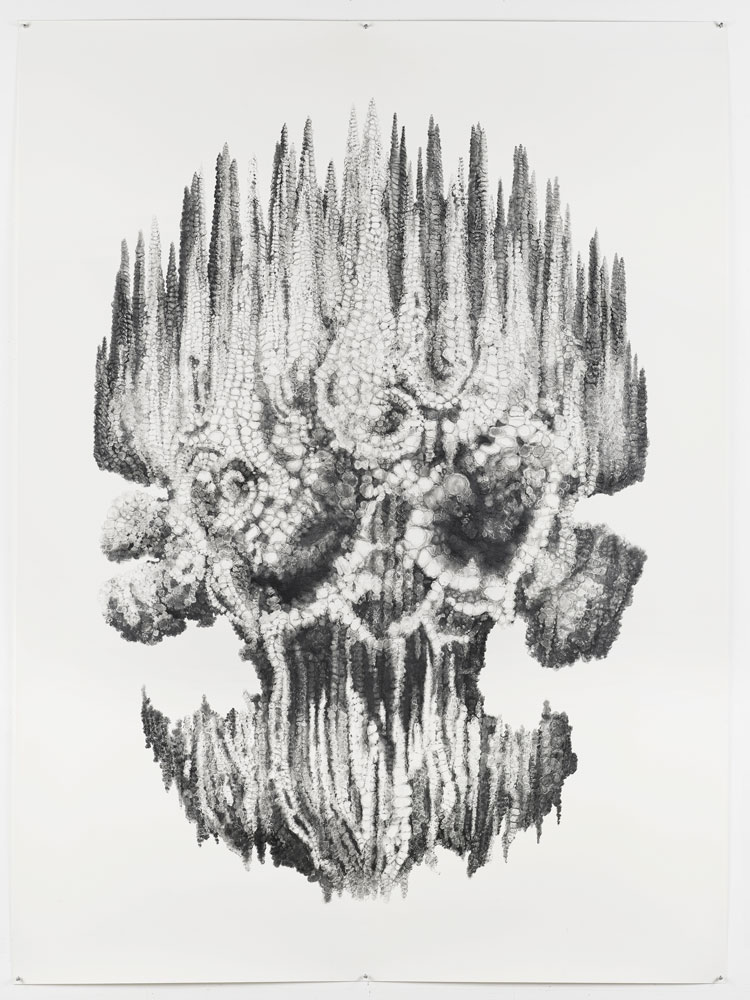
Kate Atkin. Oiwa, 2021. Pencil on paper, 231.5 x 171 cm. © the artist.
Atkin’s rich accumulations of marks and wispy, sinuous lines variously suggest thick foliage, billowing smoke, skeletal coral, twisted root systems and gnarled bark. While natural forms such as trees, roots, shells and rocks provide the starting point for many of her drawings, they are made to look strange and unfamiliar, appearing deformed, mutated or in the process of disintegrating. They remind us of nature’s capacity for both beauty and ugliness, while also hinting at ecological concerns, suggesting a fragile world on the brink of environmental calamity. Sometimes, her drawings display anthropomorphic qualities and many of her floating forms contain phantasmic faces – hallucinatory skull-like visages that seem to haunt the page.
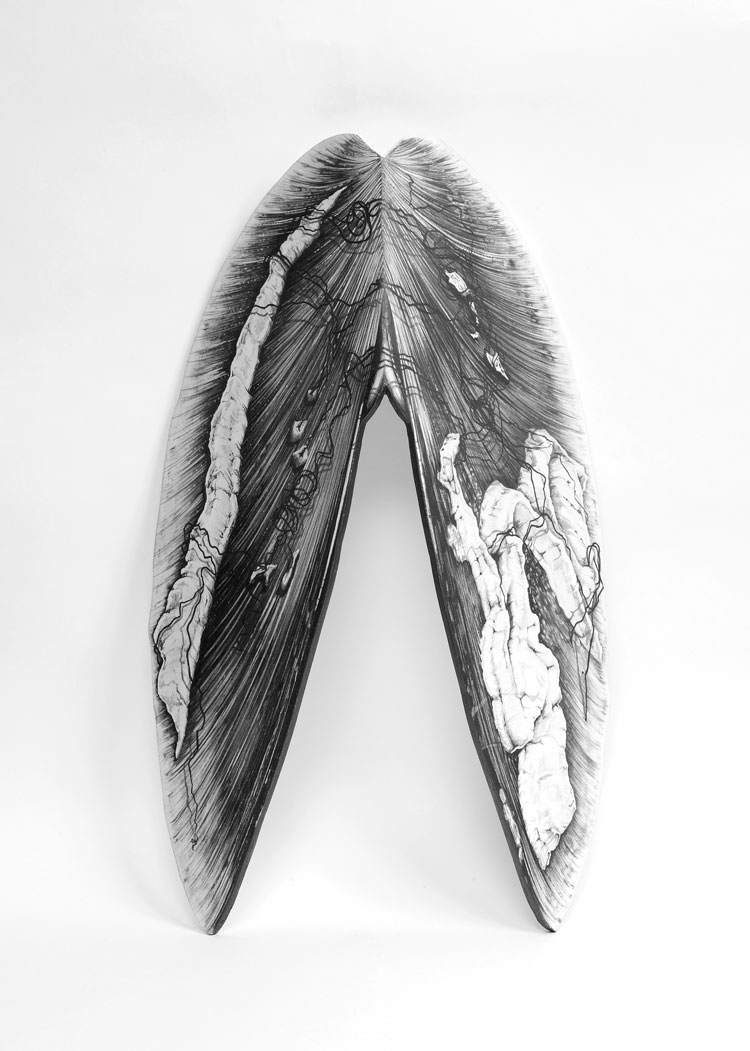
Kate Atkin. Study: A Face Like Julius Caesar and Pale Green Hair, 2011. Pencil, gesso, structura, plywood, pins, glue, 47 x 28 x 9.5 cm. © the artist.
Atkin’s interest in structures and sculptural forms has led to various three-dimensional experiments, including a series of drawings on plywood cutouts, which hang from ceilings or are propped against walls. A Face Like Julius Caesar and Pale Green Hair (2012) is a towering, wing-like structure based on a mussel shell in reference to the work of Marcel Broodthaers (1924-76), an artist whom Atkin admires for his incongruous juxtapositions and visual paradoxes. Another, Hanging Bacon (2012), joins forms from the paintings of Francis Bacon with a surface of undulating marks suggestive of both fur and bark. More recently, Atkin has been creating micro sculptures from wire and white clay. These new works, which she refers to as “Motes”, riff on details from her drawings and are unlike anything she has made before.
Studio International spoke to Atkin on the eve of her exhibition, Floating Heads, at Xxijra Hii, a new project space in Deptford, London.
David Trigg: You originally studied photography at the Royal College of Art. Why did you switch to drawing?
Kate Atkin: I had finished the first year of the two-year course at the RCA, but I was just drawing a total blank. During the summer holidays, a friend of mine, John Strutton, who had a project space with Alan Miller, called 39, invited me to be in a group show where each artist was given 10 Polaroids to go away and do something with. I did a performance piece – I went for a swim with some swans in the pond in Hyde Park. I started feeding the swans, then swam out with them, fully clothed. My sister took the photos. On the way back, I snapped one of the nearby trees, just to use up the last photograph. That picture hung around my studio for a while after that and it gradually grew on me. Eventually, I got fixated on it. That one Polaroid basically spawned my whole drawing practice.
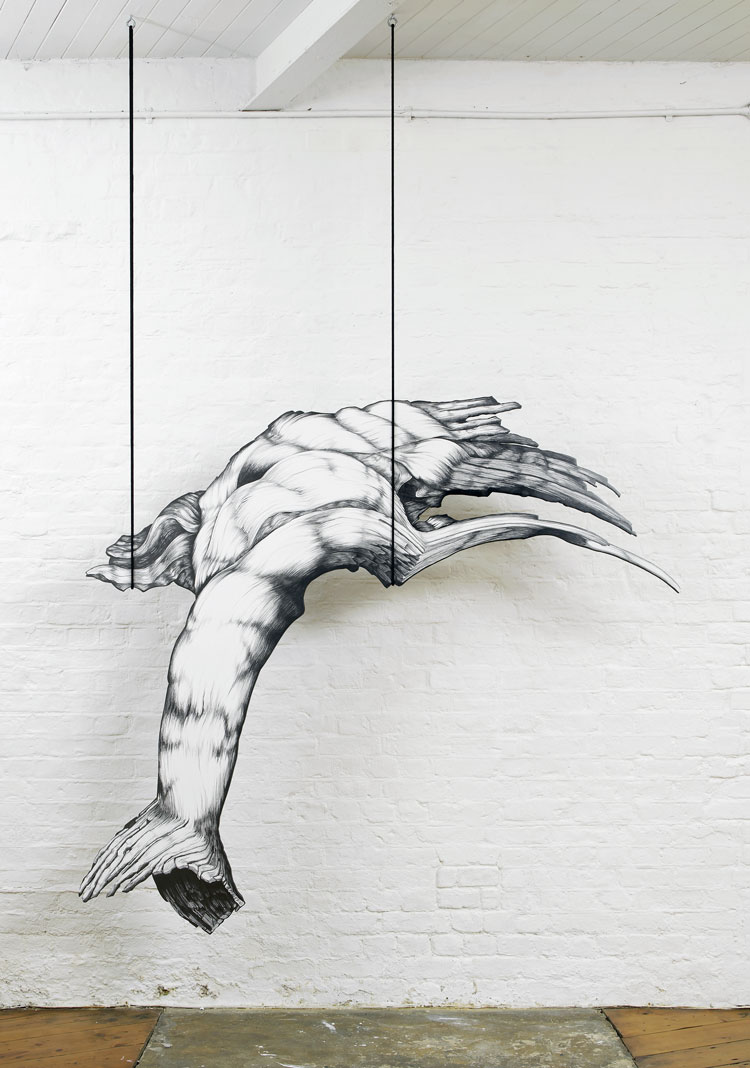
Kate Atkin. Hanging Bacon, 2012. Pencil, gesso, Structura, birch plywood, rope, 158 x 188 x 1.8 cm. © the artist.
DT: What attracted you to the image?
KA: It was of a giant pollarded tree, which was just growing its leaves back; it looked like a body covered in fur. It had this strange, soft, blurriness and was so weird and anthropomorphic. I felt like there was more to it somehow, that there were suggestive shapes and forms that it might be possible to bring out if I drew it. I brought the drawing back at the start of my second year and, for the first time, the tutorials went well. I had loads to say about it, from all sorts of different angles, and so I carried on making drawings from photographs.
DT: How did you develop your drawing style?
KA: It grew intuitively. I had no training in drawing so I just tried it. I started in the middle of the page and it grew out to the edges. I used the photograph really tightly for the shape, but the detail was a total invention. That first drawing is very naive, just angry scribbles. It was about generating matter on the page in the way that a tree would grow leaves. I titled it with a line from Heart of Darkness by Joseph Conrad: “… back to the earliest beginnings of the world, when vegetation rioted on the earth …’
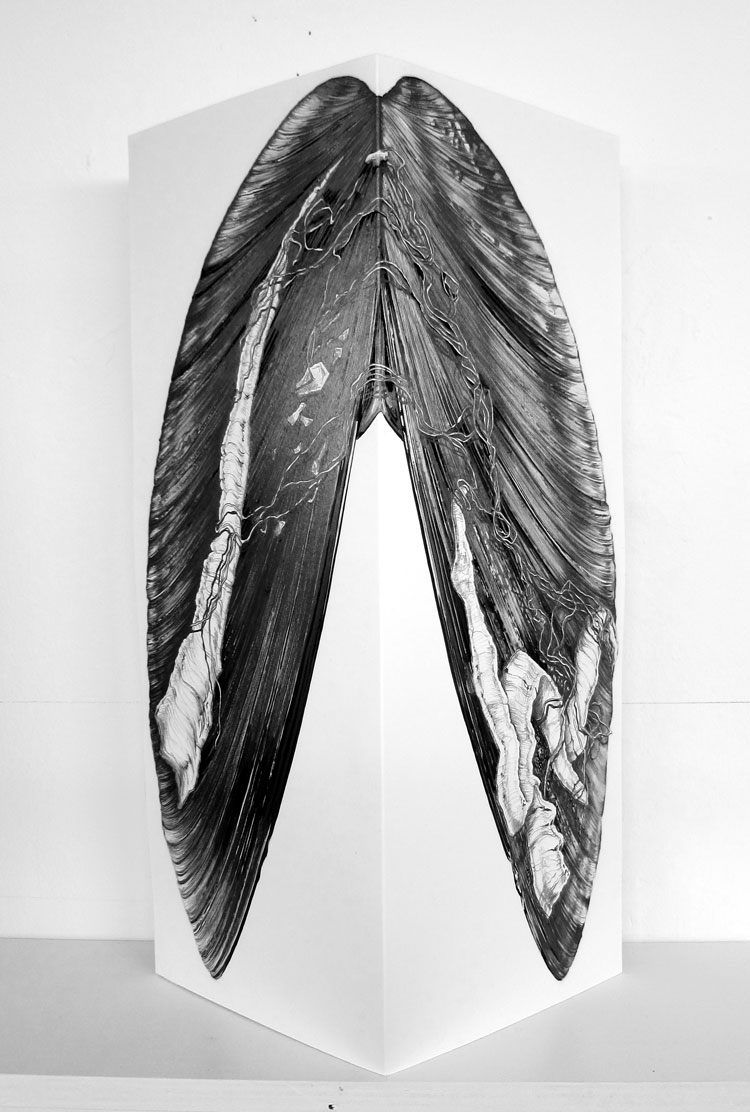
Kate Atkin. Study: Shell, 2011. Pencil and watercolour on paper with plywood support, 48.5 x 27 x 10.5 cm approx. © the artist.
DT: Natural forms inform most of your drawings – roots, shells, rocks and, most prominently, trees. What attracts you to these things?
KA: The trees that I’m really interested in are the ones growing in odd places – in a Tesco car park, or on a roundabout. Most are city or suburban trees. They have their own growth logic, but they’re managed by people so I’m interested in the effects of these two opposing forces. I also like to collect images of little objects that I spot or just find by accident – interesting things lying around on the ground, growing in a park, by the side of the road or sprouting out of a brick, which somehow seem to be interesting. Maybe they suggest a face or a certain type of atmosphere.
DT: Do you work from life or from photographs?
KA: Always from photos I’ve taken. I take them when I’m out and about, though I probably only gather a few really useful images a year. I pin them to my studio wall and if an image becomes boring over time, then I remove it. Some become more interesting the longer I look at them and, by the time it’s been on the wall for a year, I’ve got a feeling about what type of mark might be the way to start. I do a lot of small studies, but only a handful will become final works, the ones that feel really charged. I’ve got a folder full of rejects.
DT: Do you always make a small-scale preparatory drawing first?
KA: Yes, I do. The preparatory drawings inform the larger ones, which become a kind of performance of the things that I know about the image – marks and shapes emerge.
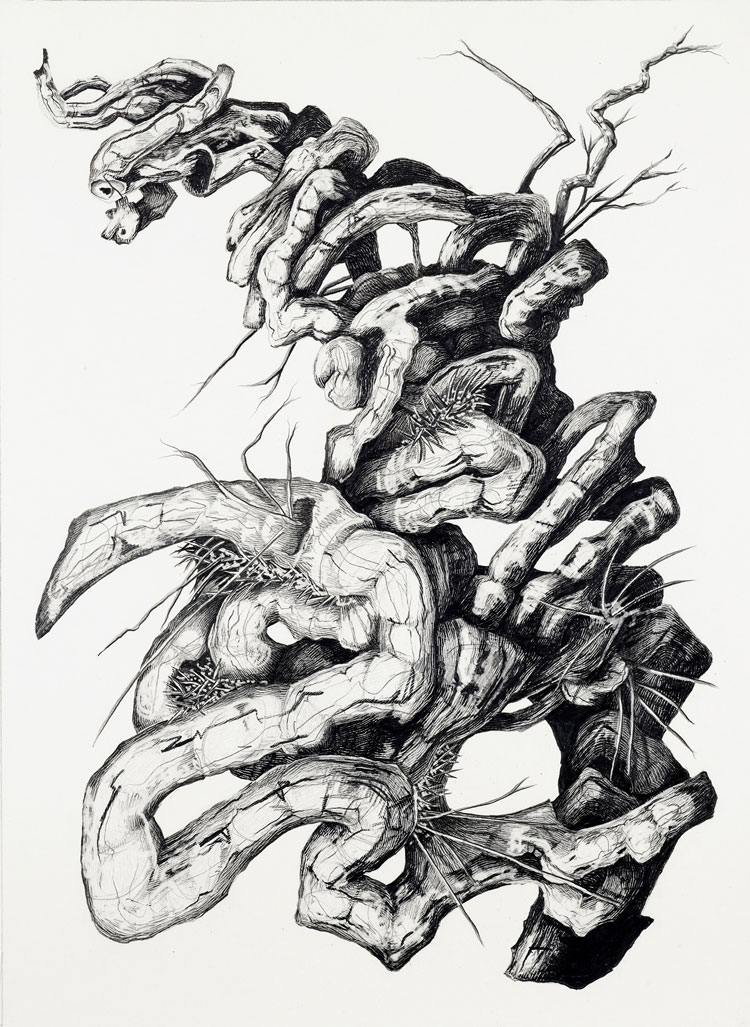
Kate Atkin. Study: The Body, 2011. Pencil on paper, 39.5 x 28.7 cm. © the artist.
DT: How does a typical drawing begin to take shape?
KA: I decide how large it should be first. Quite often, I’ll think about how it would be to stand in front of it, so some drawings tend to be really big. I deliberately print my photographs quite small, to necessitate invention; I don’t ever make anything up from scratch, but I don’t copy it completely from reality. Then I usually start in the middle of the page and let the drawing spread from the centre to the edges. Each section has an under-drawing using a very hard pencil – it’s like a skeleton and makes a groove in the paper that will be picked up later. Then I go through the grades of pencil, from hard to soft, responding to earlier, lighter marks with darker ones. At a certain point, as the image is growing on the page, I start to think more about the white space surrounding the image and the shapes it makes.
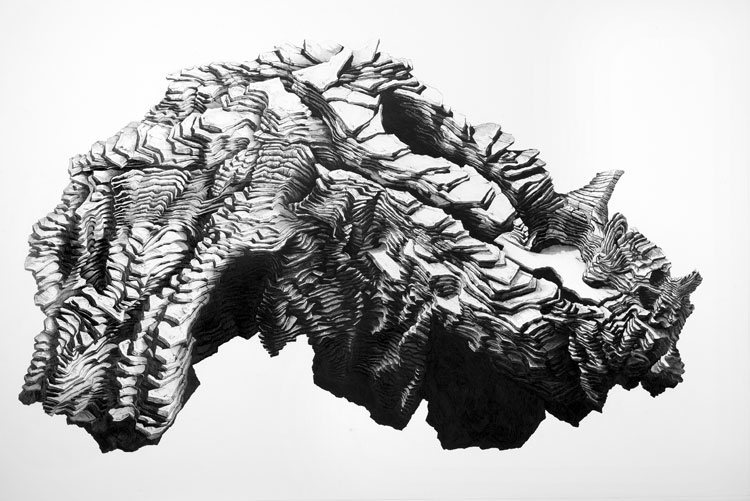
Kate Atkin. Head, August 2010. Pencil on paper, 120 x 188.7 cm. © the artist.
DT: The negative space is an important element?
KA: Yes, I think about it as much as the drawn image. I’m very particular about not smudging and not straying outside the image, which I want to feel as if it has just appeared or grown there by itself.
DT: Tell me about the phantasmic faces that often appear in your drawings.
KA: I’ve got a friend who has pareidolia – the tendency to see faces in everything. He reckons that he has it in the most intense way you can imagine. It’s a bit like that for me, too. I’m attracted to things that look like faces or bodies. I’ve always been interested in the creepy and the gothic, so maybe it’s a bit about taking fright or haunting. I feel like the heads become more alive as they progress and, at some point, they almost start returning your gaze, as if they’re looking back at you. They’re a bit zombie-like.
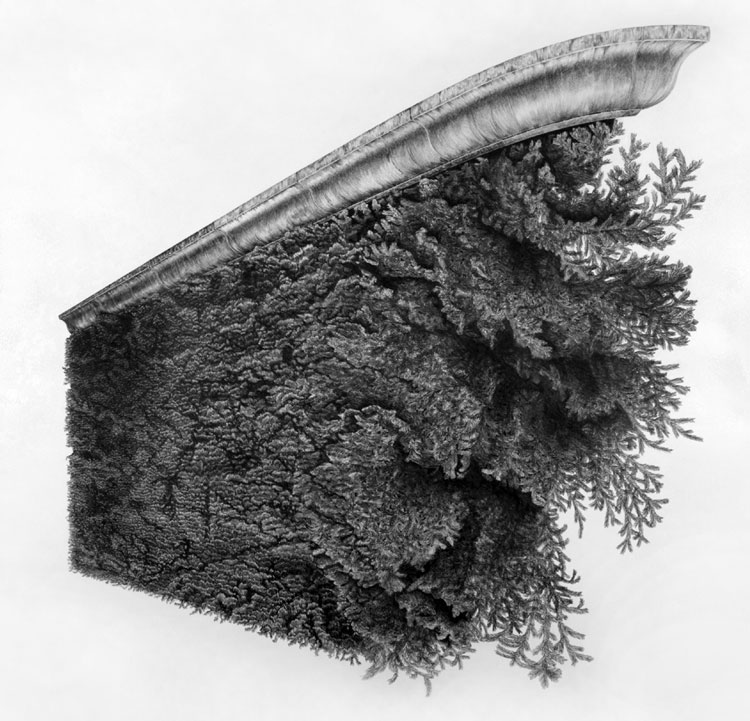
Kate Atkin. Lines & Sections; Line I, 2005. Pencil on paper, 153 x 157 cm. © the artist.
DT: You allude to these ideas in the title of your new exhibition at Xxijra Hii: Floating Heads.
KA: I went to Japan for a residency a couple of years ago and I got really into the Japanese ghost stories, which quite often feature disembodiment. One of the drawings in the exhibition is called Oiwa, which is named after Hokusai’s Ghost of Oiwa, an image of a lantern being possessed by the disembodied head of a woman murdered by her cheating husband to get her out of the way. I had the image hanging around my studio for a long time and recently I was riffling through my papers and found it again and realised how amazingly similar it looks to my drawing; it’s as if the shape of Hokusai’s disembodied head somehow found its way into my drawing unconsciously.
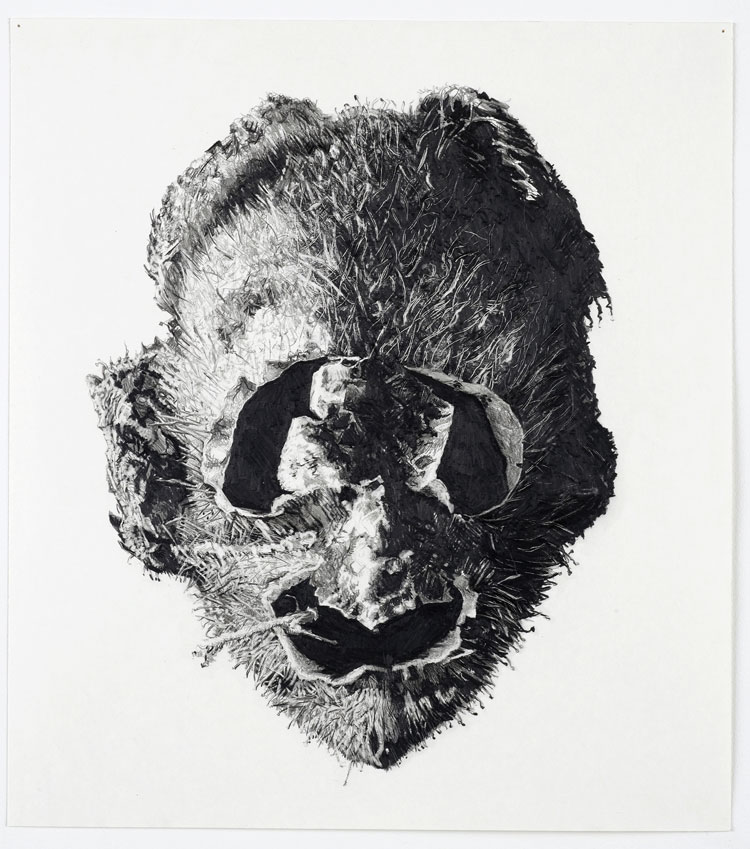
Kate Atkin. Study: Seed Head, 2016. Pencil on paper, 43.8 x 39.2 cm. © the artist.
DT: The face in your drawing Study: Seed Head (2016) also looks pretty gruesome.
KA: That is a snapdragon seed husk seen under a microscope. Snapdragon seeds all look like floating skulls and they all have different facial expressions; they’re really weird. They’re small though, so it’s hard to see the details with the naked eye. I found many seeds to be surprising when you look at them under a microscope. I held my camera to the eyepiece so the photograph is a little fuzzy, which, for me, is quite useful because I don’t want the photo to tell me too much, I want to be able to think about the details as I’m drawing.
.jpg)
Kate Atkin. Oiwa, 2021 (detail). Pencil on paper, 231.5 x 171 cm. © the artist.
DT: Do you work on more than one drawing at a time?
KA: Yes, I quite often work in pairs. This show is going to have two large drawings in it, which I’ve made to be seen together. In the gallery, you’ll be able to see both at the same time, so you’ll be being looked at by two faces, each of which have differing expressions. The drawings often inform each other; I’ll do one and it suggests what the next one will be and then the next drawing might start to suggest an object, so I make the object and then that will suggest the next object. I’ll often start the next drawing before finishing the first, which is sometimes left slightly unfinished. Knowing when to stop is really important.
DT: How do you know when enough is enough?
KA: I find I start drawing more and more slowly, until some days I just come to the studio and don’t put pencil to paper. If I have enough of those days, where I spend hours looking at it and very little time is spent making contact with the paper, then I know it is finished.
-2021.jpg)
Kate Atkin. Motes (group 1), 2021. © the artist.
DT: You’re also showing some new three-dimensional works, which you are calling “Motes”.
KA: They’re something I’ve been trying out lately. They are like drawings without paper, like a single line of pencil detached from its support. Some are plain wire lines, but others have white clay over them, which is like a reversal of drawing – instead of the line sitting on a white support, it becomes encased underneath it. For me, making objects started before drawing. As a youngster, I used to make things all the time and I didn’t really draw that much. I made things out of scrap paper, anything lying around. My mum had bin bags full of it.
-2021.jpg)
Kate Atkin. Motes (group 2), 2021. © the artist.
DT: How did these pieces begin?
KA: A lot of my time is spent making repetitive marks and when I go to bed at night I still see the shapes on the inside of my eyelids. The little wire objects I’ve been making are like hallucinations, or wisps of vapour coming off the drawings. They’re barely there, just little wisps of ideas drifting about nearby. I was thinking about facial features and exterior and interior body parts, but it’s not really clear what they are.
DT: In many of your drawings, such as Alive is Afoot (2021), nature seems to be disintegrating or breaking down. Is there an ecological or environmental subtext to these works?
KA: No, it’s not really about that. I am interested in those living things being wrestled about in sometimes violent ways, but I’m not really making a judgment about it. I do feel a little bit of pity for them though.
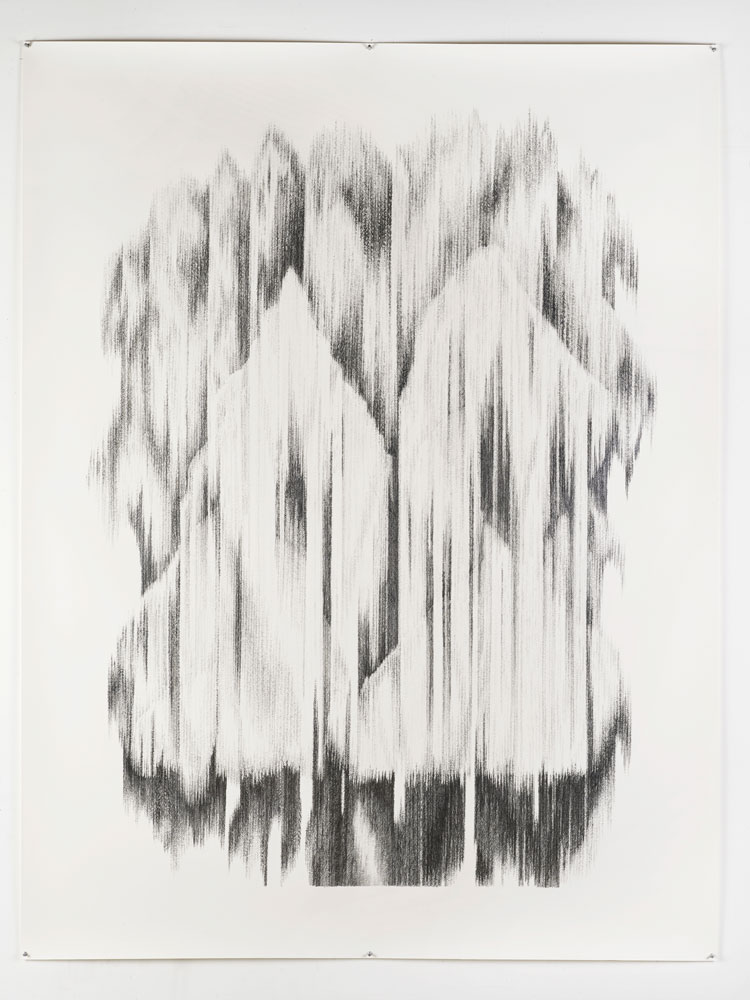
Kate Atkin. Alive is Afoot, 2021. Pencil on paper, 214.5 x 162.5cm. © the artist.
DT: Mortality also seems to be an important theme.
KA: Yes, the floating heads do relate to the idea of memento mori, to life and death and about what is left behind after death. I think about it all the time, about what I do with my time while I’m here and how long I’ve got. It probably relates to the amount of time I spend poring over one piece of paper; it takes me months to make a single drawing.
• Kate Atkin: Floating Heads is at Xxijra Hii, London, until 24 July 2021.